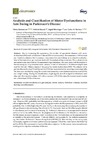Please use this identifier to cite or link to this item:
https://accedacris.ulpgc.es/jspui/handle/10553/70136
| DC Field | Value | Language |
|---|---|---|
| dc.contributor.author | Steinmetzer, Tobias | en_US |
| dc.contributor.author | Maasch, Michele | en_US |
| dc.contributor.author | Bönninger, Ingrid | en_US |
| dc.contributor.author | Travieso González, Carlos Manuel | en_US |
| dc.date.accessioned | 2020-02-05T12:52:37Z | - |
| dc.date.available | 2020-02-05T12:52:37Z | - |
| dc.date.issued | 2019 | en_US |
| dc.identifier.issn | 2079-9292 | en_US |
| dc.identifier.other | Scopus | - |
| dc.identifier.other | WoS | - |
| dc.identifier.uri | https://accedacris.ulpgc.es/handle/10553/70136 | - |
| dc.description.abstract | Due to increasing life expectancy, the number of age-related diseases with motor dysfunctions (MD) such as Parkinson’s disease (PD) is also increasing. The assessment of MD is visual and therefore subjective. For this reason, many researchers are working on an objective evaluation. Most of the research on gait analysis deals with the analysis of leg movement. The analysis of arm movement is also important for the assessment of gait disorders. This work deals with the analysis of the arm swing by using wearable inertial sensors. A total of 250 records of 39 different subjects were used for this task. Fifteen subjects of this group had motor dysfunctions (MD). The subjects had to perform the standardized Timed Up and Go (TUG) test to ensure that the recordings were comparable. The data were classified by using the wavelet transformation, a convolutional neural network (CNN), and weight voting. During the classification, single signals, as well as signal combinations were observed. We were able to detect MD with an accuracy of 93.4% by using the wavelet transformation and a three-layer CNN architecture. | en_US |
| dc.language | eng | en_US |
| dc.relation.ispartof | Electronics (Switzerland) | en_US |
| dc.source | Electronics (Switzerland) [ISSN 2079-9292], v. 8 (12), p. 1-15 | en_US |
| dc.subject | 3314 Tecnología médica | en_US |
| dc.subject.other | Gait Analysis | en_US |
| dc.subject.other | Inertial Sensors | en_US |
| dc.subject.other | Machine Learning | en_US |
| dc.subject.other | Parkinson’S Disease | en_US |
| dc.subject.other | Wavelet Transformation | en_US |
| dc.subject.other | Wearable Sensors | en_US |
| dc.title | Analysis and classification of motor dysfunctions in arm swing in parkinson’s disease | en_US |
| dc.type | info:eu-repo/semantics/article | en_US |
| dc.type | Article | en_US |
| dc.identifier.doi | 10.3390/electronics8121471 | en_US |
| dc.identifier.scopus | 85076025107 | - |
| dc.identifier.isi | 000506678200097 | - |
| dc.contributor.authorscopusid | 57204115368 | - |
| dc.contributor.authorscopusid | 57212143523 | - |
| dc.contributor.authorscopusid | 56395430400 | - |
| dc.contributor.authorscopusid | 6602376272 | - |
| dc.identifier.eissn | 2079-9292 | - |
| dc.identifier.issue | 12 | - |
| dc.relation.volume | 8 | en_US |
| dc.investigacion | Ingeniería y Arquitectura | en_US |
| dc.type2 | Artículo | en_US |
| dc.contributor.daisngid | 34756291 | - |
| dc.contributor.daisngid | 34775863 | - |
| dc.contributor.daisngid | 7765108 | - |
| dc.contributor.daisngid | 265761 | - |
| dc.description.numberofpages | 15 | en_US |
| dc.utils.revision | Sí | en_US |
| dc.contributor.wosstandard | WOS:Steinmetzer, T | - |
| dc.contributor.wosstandard | WOS:Maasch, M | - |
| dc.contributor.wosstandard | WOS:Bonninger, I | - |
| dc.contributor.wosstandard | WOS:Travieso, CM | - |
| dc.date.coverdate | Diciembre 2019 | en_US |
| dc.identifier.ulpgc | Sí | en_US |
| dc.contributor.buulpgc | BU-TEL | en_US |
| dc.description.sjr | 0,303 | |
| dc.description.jcr | 2,412 | |
| dc.description.sjrq | Q2 | |
| dc.description.jcrq | Q2 | |
| dc.description.scie | SCIE | |
| item.fulltext | Con texto completo | - |
| item.grantfulltext | open | - |
| crisitem.author.dept | GIR IDeTIC: División de Procesado Digital de Señales | - |
| crisitem.author.dept | IU para el Desarrollo Tecnológico y la Innovación | - |
| crisitem.author.dept | Departamento de Señales y Comunicaciones | - |
| crisitem.author.orcid | 0000-0002-4621-2768 | - |
| crisitem.author.parentorg | IU para el Desarrollo Tecnológico y la Innovación | - |
| crisitem.author.fullName | Travieso González, Carlos Manuel | - |
| Appears in Collections: | Artículos | |
SCOPUSTM
Citations
10
checked on Jun 8, 2025
WEB OF SCIENCETM
Citations
9
checked on Jun 8, 2025
Page view(s)
101
checked on Mar 9, 2024
Download(s)
53
checked on Mar 9, 2024
Google ScholarTM
Check
Altmetric
Share
Export metadata
Items in accedaCRIS are protected by copyright, with all rights reserved, unless otherwise indicated.
